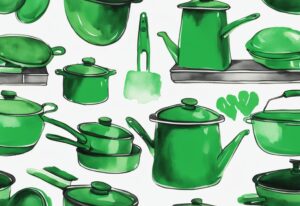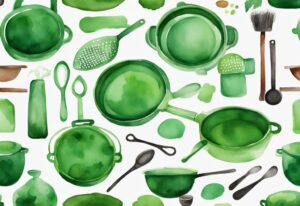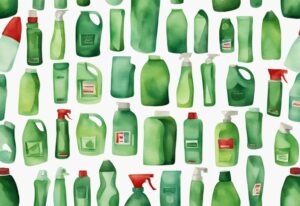Discover What Pans Are Non Toxic: The Ultimate Healthy Cookware Guide
Did you know the pans you use to cook could be a hidden source of toxins in your home? It’s a sobering thought, isn’t it? But worry not, we’ve compiled the most comprehensive guide on non-toxic pans right here at Nontoxicways.com. You’re just a few paragraphs away from transforming your kitchen into a safer space!
This detailed guide will outline the best non-toxic pans available, stacked with research-supported details and handy tips. We’ve done the legwork for you, unmasking the risks of toxic pans and enlightening you on healthier alternatives.
By the end, you’ll be able to confidently choose cookware that keeps your meals safe and savory. Let’s dive into the fascinating world of non-toxic cookware and march towards a healthier lifestyle together. Welcome to your journey to a toxin-free kitchen!
Understanding the Importance of Non-Toxic Pans
Non-toxic cookware represents a conscious choice towards health and well-being, avoiding the myriad of hazardous chemicals prevalent in conventional nonstick options. Below, we delve deeper into defining non-toxic cookware and explore the compelling reasons to make the switch to these safer alternatives.
Defining Non-Toxic Cookware
Non-toxic cookware is identified by the absence of harmful nonstick coatings and chemicals such as PFAS, PTFE (Teflon), and PFOA. Opting for non-toxic pans means prioritizing materials known for their safety and durability. Stainless steel, cast iron, carbon steel, pure ceramic, and glass top the list of safe materials. Additionally, coated cookware that uses ceramic instead of PFAS and PTFE coatings is considered non-toxic.
The hallmark of non-toxic cookware is its purity from harmful chemicals like GenX, a replacement for older harmful nonstick chemicals, which is still under scrutiny for its health impacts. Therefore, understanding what pans are non-toxic involves checking for the absence of these dangerous substances and ensuring the materials are food safe.
The Health Risks of Toxic Cookware and Why Non-Toxic is Better
Certain cookware can release hazardous chemicals into food when heated, posing significant health risks. PFAS, PFOS, and PTFE, often termed “Forever Chemicals” due to their persistence in the environment, can accumulate in the human body over time. These substances are linked to severe health issues, including cancer, liver damage, and hormone disruption. For a deeper understanding of the risks associated with nonstick cookware, including the presence of PFAS, check out this informative article from America’s Test Kitchen.
Making the switch to non-toxic pans mitigates these risks, fostering a healthier cooking environment. Additionally, non-toxic cookware benefits the planet by reducing the carbon footprint and preventing chemical leaching into ecosystems. By choosing non-toxic pans, you contribute to a healthier future while safeguarding your well-being.
The Best Non-Toxic Pan Options
Unveiling the Benefits of Stainless Steel Pans
Stainless steel pans have been a reliable favorite in my kitchen for years, and it’s easy to see why. They are free from harmful coatings, ensuring no chemicals leach into our meals. When choosing stainless steel, look for food-grade 18/10 stainless steel—18% chromium and 10% nickel. This combination guarantees corrosion resistance and a smooth cooking surface.
I love how stainless steel distributes heat evenly, eliminating hot spots for perfectly cooked dishes every time. Plus, with proper care, these pans can be passed down through generations, making them a valuable, long-lasting investment.
Why You Should Choose Cast Iron Pans
Cast iron pans are another beloved staple in my kitchen. The natural nonstick surface that forms with seasoning enhances both the cooking performance and longevity of these pans. While they require a bit of maintenance—avoiding prolonged cooking of acidic foods, for example—their durability and even heat distribution are unparalleled. For those truly committed to healthier cooking practices, cast iron pans offer a timeless, non-toxic solution.
Everything You Need to Know about Carbon Steel Pans
Carbon steel pans have recently become a favorite of mine, offering a lighter weight alternative to cast iron with excellent heat conduction. Like cast iron, they need to be seasoned to develop nonstick properties and protect against rust. I appreciate their versatility, especially for high-heat cooking methods like searing and stir-frying. They strike a perfect balance between performance and ease of use, making them a standout choice for non-toxic cooking.
An Introduction to Pure Ceramic Cookware
I’ve always been drawn to pure ceramic cookware, made from natural materials like clay, water, and minerals. Free from harmful coatings, it’s a great choice for those prioritizing non-toxic cooking. Pure ceramic can be less durable and needs careful handling to maintain its quality. Avoiding sudden temperature changes and using non-abrasive cleaning tools can extend its lifespan. Despite needing a bit of extra care, I find pure ceramic cookware a delightful and health-conscious option.

Is Ceramic-Coated Nonstick Cookware Safe?
Ceramic-coated nonstick cookware offers the convenience of nonstick cooking without the harmful chemicals found in traditional nonstick options. It’s crucial to verify that the coating is genuinely ceramic and not mixed with other materials. This cookware is great for medium to medium-low heat cooking. When carefully chosen and maintained, it provides a safe, non-toxic cooking experience combined with the ease of nonstick properties.
Exploring Enameled Cast Iron Cookware
Enameled cast iron cookware combines the durability of cast iron with easier maintenance, thanks to its enamel coating. This coating offers some nonstick properties and eliminates the need for seasoning. I find it perfect for a variety of dishes, merging the toughness of cast iron with a smooth, easy-to-clean surface. It’s truly versatile and a practical choice for anyone looking to incorporate safer cookware into their kitchen.
Copper Cookware with Stainless Steel Lining: Is it Non-Toxic?
Copper cookware lined with stainless steel is another wonderful non-toxic option. The stainless steel lining prevents copper from leaching into the food, making it safe. While regular maintenance is needed to keep the copper exterior shiny, the combination delivers both safety and excellent cooking performance. This dual advantage makes it a worthwhile addition to the kitchen.
Discovering the Advantages of Glass Cookware
Glass cookware is a transparent, non-toxic option that doesn’t react with food or contain harmful coatings. I find it particularly useful for baking and food storage, although it’s less common for stovetop cooking due to its fragility. The ability to see through the glass allows monitoring of the cooking process without lifting the lid. While it requires careful handling, glass cookware remains a safe and healthy choice for various culinary tasks.
Titanium Cookware: A Safe Alternative?
Titanium cookware is impressive for its non-toxic properties and resistance to scratches and wear. Titanium doesn’t react with food, ensuring a safe cooking experience. Often combined with other materials to boost durability and heat conduction, titanium cookware stands out as robust and reliable. These features make it an excellent choice for anyone seeking a safe and long-lasting cooking solution.
Anodized Aluminum Cookware: What You Need to Know
Anodized aluminum cookware prevents aluminum from leaching into food through a hard, non-reactive surface created by the anodization process. While this cookware is more durable than regular aluminum, it’s essential to maintain the anodized layer to preserve its non-toxic properties. When properly cared for, anodized aluminum cookware offers a reliable and safe cooking experience, coupling the benefits of aluminum with added safety and durability.
How to Choose Safe, Non-Toxic Cookware
Piercing Through Misleading Labels
Many cookware products boast labels such as “PFOA-free” and “PTFE-free,” which can be misleading. These claims might create a false sense of security while still containing other harmful chemicals.
It’s crucial to scrutinize the materials and manufacturing processes used by the manufacturer. Look beyond catchy marketing phrases and ensure the cookware is made from truly non-toxic substances, like stainless steel or pure ceramic. Checking the ingredient list or product composition can provide a clearer picture of what you’re purchasing.
Importance of Third-Party Testing and Certifications
To guarantee the safety of non-toxic cookware, third-party testing is essential. Reputable laboratories verify that the cookware meets strict safety standards, ensuring it is free from harmful chemicals.
Certifications such as California Prop 65 are beneficial as they indicate the absence of heavy metals and toxic substances. Clear labeling that details these certifications helps consumers make informed decisions. When in doubt, choose products that openly discuss their testing procedures and certification credentials.
The Lowdown on Heavy Metals
Heavy metals like lead and cadmium, commonly found in some cookware glazes, pose significant health risks. Exposure to these elements can lead to various health issues, making it imperative to choose cookware certified free from these hazardous materials.

Products labeled as free from heavy metals provide a safer cooking experience. Special caution is needed when using antique or older cookware, which is more likely to contain harmful heavy metals. Always verify the safety of your cookware to ensure it complies with current health and safety standards.
Caring for Your Non-Toxic Cookware
Maintaining the non-toxic integrity of your cookware is crucial for ensuring both the longevity of the cookware and the safety of your meals. Offering specialized care, depending on the type of cookware, prevents damage and preserves its health benefits. Here are some insightful tips to keep your non-toxic cookware in excellent condition:
Essential Care and Maintenance Tips for All Non-Toxic Cookware
- Avoid Using Metal Utensils: I’ve learned through trial and error that using wooden, silicone, or plastic utensils with ceramic or nonstick surfaces can make all the difference. Metal utensils can scratch the surface, potentially allowing harmful substances to leach into your food over time.
- Season Cast Iron and Carbon Steel: One of my favorite rituals is seasoning my cast iron and carbon steel cookware. This process involves applying a light coat of oil on the surface and baking it. Regular seasoning keeps the cookware naturally nonstick and rust-free, ensuring you can enjoy flawless cooking experiences.
- Avoid Cooking Very Acidic Foods: When it comes to acidic foods like tomatoes or citrus fruits, I stick to more suitable cookware. Using cast iron or carbon steel for long periods with such foods can compromise the seasoned layer. I reserve these pans for searing, frying, or baking non-acidic dishes, which helps them last longer.
- Preheat Stainless Steel Pans: Every time I use my stainless steel pans, I make sure to preheat them before adding oil. This small step minimizes sticking and ensures heat is evenly distributed, making my culinary endeavors more successful and enjoyable. For more information on safe and healthy cooking options, check out our list of non-toxic dinnerware brands.
- Follow Manufacturer’s Guidelines: One of the best practices I follow is adhering to the manufacturer’s guidelines for cleaning and maintaining non-toxic cookware. Some materials may be dishwasher-safe, while others require hand washing. These guidelines help maintain the integrity of the cookware and prevent damage.
- Inspect for Wear and Tear: Regularly checking my cookware for signs of flaking or significant wear has become a routine. If any damage is found, I replace the cookware to avoid exposure to harmful substances. Keeping cookware in good condition ensures a safe and non-toxic cooking environment.

Frequently Asked Questions:
Which Non-Toxic Pans are the Safest?
When it comes to finding the safest non-toxic pans, options like pure ceramic, stainless steel, cast iron, and titanium cookware truly shine. I’ve found that copper cookware with a stainless steel lining is also a trusty ally in the kitchen. It’s crucial to ensure that whatever cookware you choose is free from harmful coatings and chemicals, giving peace of mind for everyday cooking.
Are Ceramic Pans Really Non-Toxic?
Pure ceramic pans are crafted from natural materials, making them a wonderful non-toxic choice. However, ceramic-coated pans require a bit more scrutiny. They’re generally safe if they steer clear of harmful chemicals such as PFAS and PTFE. I always double-check the materials and steer clear of products that merely claim to be fully ceramic but lack proper certifications or clarity.
How Can I Tell If My Existing Cookware is Non-Toxic?
To determine if your cookware is non-toxic, look for labels that indicate the absence of harmful chemicals like PFAS, PTFE, and PFOA. I always examine the material composition; cookware crafted from stainless steel, cast iron, and pure ceramic tends to be reliable. Third-party certifications can offer further assurance about the safety of your cookware.
Is Non-stick Cookware Safe?
Many traditional non-stick pans are made with harmful chemicals like PFAS and PTFE, which pose safety concerns. As a safer alternative, I recommend ceramic-coated nonstick cookware that avoids these chemicals. Always ensure that any nonstick cookware you use is certified to be free from PFAS, PTFE, and similar substances to ensure your meals are cooked safely.
What Does PFAS Mean and Why Should I Avoid It?
PFAS, often referred to as “Forever Chemicals,” are substances that don’t break down and can build up in your body. These chemicals are linked to severe health issues, including cancer, liver damage, and hormone disruption. By avoiding cookware that contains PFAS, you can significantly reduce your exposure to these harmful substances, thereby promoting a healthier lifestyle for you and your family.
Conclusion: Making the Switch to Non-Toxic Pans
Choosing Non-Toxic Cookware for Health and Environmental Benefits
Opting for non-toxic pans is an essential step towards a healthier lifestyle and a more sustainable environment. Harmful chemicals found in traditional cookware, such as PFAS, PTFE, and PFOA, can leach into food, posing significant health risks. By eliminating these toxic substances and choosing non-toxic cookware, you ensure a safer cooking experience for you and your family. This switch also reduces the environmental impact caused by chemical contamination, and that’s something we can all feel good about.
Durable and Safe Materials for Lasting Cookware
When selecting non-toxic pans, prioritize durable materials like stainless steel, cast iron, and pure ceramic. Stainless steel, especially food-grade 18/10, provides a reliable and long-lasting option that withstands high temperatures and resists corrosion. Cast iron offers exceptional heat retention and natural nonstick properties when properly seasoned. Pure ceramic cookware, made from natural materials, ensures a non-reactive cooking surface free from harmful coatings, though its durability may vary.
Third-Party Certifications and Material Examination
To confidently determine what pans are non-toxic, it’s crucial to verify the absence of harmful chemicals through third-party certifications. Look for labels such as California Prop 65, which indicate compliance with strict safety standards and the absence of heavy metals like lead and cadmium.
Additionally, examine product materials and manufacturing processes to ensure the cookware is genuinely non-toxic. Avoid being misled by marketing terms and instead focus on the verified safety credentials of the product. This diligence will give you peace of mind and ensure that your choice is truly safe.
Proper Care and Maintenance for Longevity
Extending the lifespan of your non-toxic pans requires diligent care and maintenance. For ceramic or nonstick surfaces, avoid using metal utensils to prevent scratching. Regularly season cast iron and carbon steel pans to maintain their nonstick properties and protect the surface. For more detailed guidance, check out our recommendations for the best turmeric soap for dark spots. When cooking with stainless steel, preheat the pan before adding oil to reduce sticking. Follow the manufacturer’s guidelines for cleaning and avoid using abrasive cleaners that may damage the surface.
By maintaining your cookware properly, you can enjoy a safe and efficient cooking experience for years to come.
By making these informed choices and adopting proper care routines, you are not only enhancing your culinary experience but also contributing to a healthier home and a more sustainable planet. This journey toward non-toxic living is filled with small, impactful changes that make a big difference.
Hi, I’m Olivia Green, the voice behind nontoxicways.com. I’m passionate about helping you make the shift to a healthier, non-toxic lifestyle without feeling overwhelmed. I love sharing my personal journey, from small changes to big transformations, along with practical tips that make it all feel doable. My goal is to inspire and guide you toward a lifestyle that benefits both your well-being and the planet. Let’s take this journey together, one simple step at a time!














Post Comment